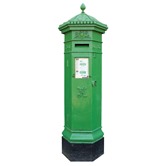Counting down to postcodes
 Peter Cheney sums up how the new postcode system will work from next year. While Ireland has lagged behind the rest of Europe, Irish postcodes will be the first to identify individual properties using GPS technology.
Peter Cheney sums up how the new postcode system will work from next year. While Ireland has lagged behind the rest of Europe, Irish postcodes will be the first to identify individual properties using GPS technology.
More than forty years after they made their UK debut, Ireland’s postcodes will be announced by letter next spring. Some 2.2 million business and household addresses will be assigned a unique code and technological advances will make this the most precise system in Europe.
Dublin’s postal districts were introduced in 1917 but elsewhere in the State the postal system has continued to be based on townlands and streets. Townlands fell out of everyday use in Britain during the Industrial Revolution and the accompanying amalgamations of farms in the countryside. An increasingly urbanised society demanded a more organised postal system.
UK postcodes were piloted in Norwich in 1959 and adopted nationally between 1967 and 1974. A total of 121 postcode areas currently exist – delineated by their first two letters – with the largest being Northern Ireland (BT).
Ireland is the only EU or OECD member state without a postcode system.
A 2005 working group recommended their introduction, mainly on efficiency grounds.
An Post was sceptical, pointing out that it already used a technical postcode (Geodirectory) to sort mail for delivery to all addresses in the State. It also claimed that postcodes could add significant costs and attract controversy. Residents are often very attached to existing addresses which can also determine the value of their property. The working group suggested that those objections would be overcome as long as the postcode did not change the address.
Low uptake was another risk. Using a postcode is entirely voluntary and many people in the North still end their address with a town, county or townland. Uptake in the Republic is likely to increase when organisations ask customers to provide their postcode in order to receive a service.
An Post said that compliance was ultimately explained by cultural reasons. The working group contended that Irish people quickly adapted to the euro and the smoking ban – both major policy initiatives – and clearly explaining the benefits made the process easier.
An initial template was drawn up in 2006 by the National Postcode Project Board, envisaging a six-digit alpha-numeric model. The State would be divided into around 200 post towns, which would in turn be sub-divided into groups of 40-50 properties. This would accommodate the Dublin postal districts and Irish language addresses.
Postcodes were approved in principle by the Government in 2009 and much of the groundwork was done by then Communications, Energy and Natural Resources Minister Eamon Ryan. PA Consulting managed the implementation project, which culminated in a final decision by Ryan’s successor, Pat Rabbitte, in October 2013.
The seven-digit codes are to take effect early in 2015, although the date has not yet been announced. The first three (the routing key) will be area-based with D04, for example, denoting Dublin 4. While the final total of area codes has not yet been determined, Dublin will retain its 24 districts. The intention is that non-Dublin versions will become as familiar to users as their own telephone area codes – of which there are currently 48.
The remaining four numbers comprise a permanent unique identifier for the property. Once a householder is informed of their postcode, he or she will be able to use it immediately.
Ireland will become the first country in which each property would have its own individual postcode. This draws on the Geodirectory’s comprehensive database and will close the loophole whereby 35 per cent of addresses are shared e.g. in the same apartment block, office development or townland.
 GPS software should allow drivers – and the emergency services – to locate destinations in a matter of seconds. However, the public safety benefits are limited to buildings as a postcode cannot direct an ambulance to a remote road or field.
GPS software should allow drivers – and the emergency services – to locate destinations in a matter of seconds. However, the public safety benefits are limited to buildings as a postcode cannot direct an ambulance to a remote road or field.
Delivery companies, while among the strongest supporters of postcodes, would prefer a more localised system for identifying properties to help drivers plan their journeys. However, the system does have the advantage of pinpointing an obscure address which might otherwise be hard to find.
Capita Ireland has been appointed to develop and operate the system via a subsidiary (Eircode), initially for ten years. The contract is valued at around €15 million and the Government expects that overall implementation costs will total €26 million when design, database upgrades and publicity campaigns are taken into account.
Some of the nuances of language will influence the shape of the unique identifiers. Easily confused characters will not be used e.g. 0, O, 1, I, M, N. Offensive combinations and those which resemble proper names and acronyms will be avoided.
One other small but important consideration is to ensure that adjacent addresses have different sounding postcodes – especially important in telling the difference between homes in the same rural townland. Businesses are encouraged to research the potential opportunities of postcodes, update their IT systems, prepare to add codes to customer addresses in databases, and (importantly) to delay print runs for new stationery until they know their code.





